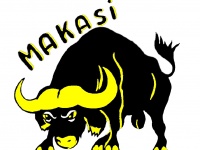211th Squadron
| 211th Squadron | |||
|---|---|---|---|
| Air Force: Congolese Air Force | |||
| Group: 2nd Group | |||
| Active: 1964- | |||
| Theater Congo | |||
| Motto: Makasi (Strong) | |||
| Aircraft: C-46, T-28, B-26 | |||
| COMMANDERS | |||
| Group CO: Joaquin "Pupy" Varela | |||
| MAIN BASES | |||
| Air fields: Albertville Stanleyville, Leopoldville | |||
| Donate | |||
| Even a small donation of a couple of dollars goes a long way in helping | |||
The Makasi Squadron was a composite squadron that operated out of the Congo as part of Operation Anstalt Wigmo.
Overview
Formally, the unit was the 211th Squadron, 2nd Group, Congolese Air Force. [1] [footnotes 1] However, unofficially none of the people in the squadron called themselves that. They instead said they were "El Grupo Voluntario Cubano" or the Cuban Volunteer Group.[2] By June 1964 the Squadron had approximately 25 pilots, mostly Cubans. [2]
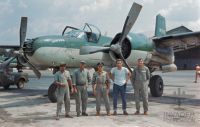
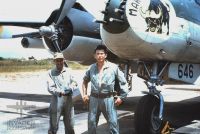
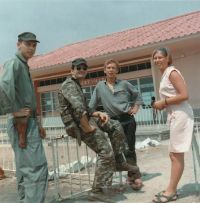
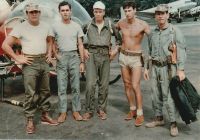
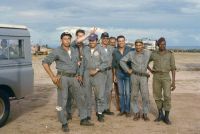
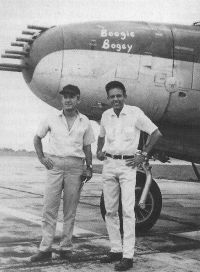
The B-26s were owned by the USAF, on loan to the CIA, based in the Congo, and flown by Cubans. The squadron had several other planes. Initially the squadron's maintenance was handled by Cubans. However, as the size and scope of the squadron grew the CIA formed a fake Belgian company called Anstalt Wigmo to handle the maintenance. They brought in over 100 European mechanics and armorers to keep the planes airworthy. [2]
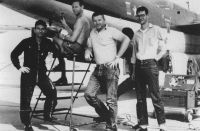
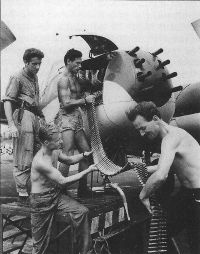
Perhaps the most important development from this operation was the improvement to the carburetor intake that was developed in the field as a means to keep the engines from overheating. These modifications became known as "Congo Cowls" and would end up as standard equipment on all B-26K models, which served the plane crews well in the harsh climates of Southeast Asia in the coming years. Note that the air intakes used in the Congo are signifanctly larger than the final version that would be adopted. The Congo Cowls on the planes in Southeast Asia have the air intakes in the same place, but the scoop is much shorter.
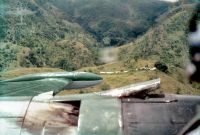
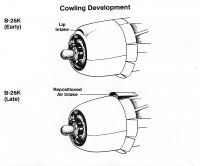
The squadron's insignia, a bull, was taken from a popular local brewery named Unibra that made a popular beer called "Polar". The name Makasi coming from the Cuban pilots, meaning "Strong" in Lingali, the native language of the Congo. [3]
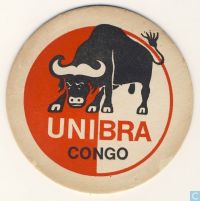
The squadron itself was a composite squadron that operated out of Leopoldville. All of the planes in the unit bore the Makasi bull emblem on the nose. Several examples from T-28D Trojans and B-26Ks are visible below. Note the very subtle difference in the lettering, particularly the last "i", and the subtle changes in the bull, particularly the ears and tail. Based on the photographic evidence, it seems as though this insignia was adopted sometime after the spring of 1965.
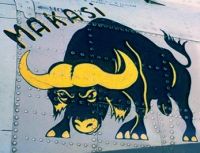
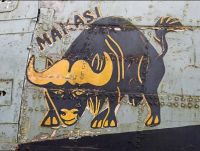
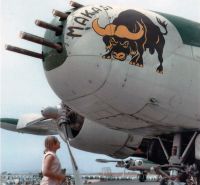
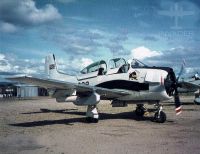
The first 3 B-26Ks arrived the night of 17 Aug 1964, having been flown in by US pilots from the 602nd Fighter Squadron. The Cuban pilots learned quickly, having some experience on the B-26 already, and flew the first combat mission on 21 Aug 1964.[2] Four B-26Bs were originally slated to go to this operation. Of these, 1 was left behind in Okinawa, another crashed and burned in Aden, and the last two arrived in-tact in September 1964. [2] The Cubans soon learned that the B-26Bs were no longer used by the Americans and were somewhat outraged over their arrival thinking them to be a deathtrap. One of the planes was never used again, instead becoming a source for spare parts. The other plane had benches installed in the bomb bay and was kept on standby as an emergency escape vehicle. Eventually, desperation and need forced them to refit the plane as a makeshift recon vehicle which the crew jokingly called "U-3" as a tongue-in-cheek reference to the U-2 spyplane.[2]
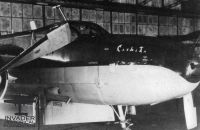
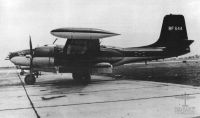



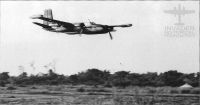
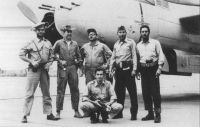
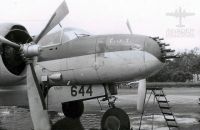
The T-28Ds and the B-26Ks performed largely the same role within the squadron - close counter insurgency operations. The tactics that would eventually become adopted included scattering the T-28Ds to multiple air fields so that they could respond everywhere more quickly and saving the harder-hitting B-26Ks for large, high-value or heavily defended targets. The B-26Ks did not carry internal bombs in the bomb bay while operating in the Congo so, instead, a long-range ferry tank was installed to give the planes extra range.[2]
By January of 1965, two more brand-new B-26Ks arrived at to join the squadron. [2]. Eventually, 649 and 662 would also get the Makasi insignia painted on the nose, but neither of these planes is known to have a name.
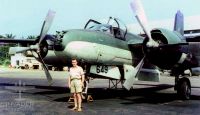

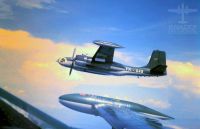
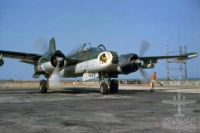

List of Planes
| USAF S/N | Registry # | Start Date | End Date | Comments |
|---|---|---|---|---|
| B-26 Invaders | ||||
| 44-35890 | 35890 & FL-890 | Sep 1964 | 1966 | B-26B named "U3" used for recon. Scrapped at Kinshasa. [2] |
| A second B-26B was send to the Congo, but it was not used.[2] A third B-26B crashed and burned in Aden on 21 Aug 1964, and a fourth was left behind in Okinawa. [2] | ||||
| 64-17644 | RF644 & FR-644 | 18 Aug 1964 | Jan 1967 | Named "Shit House Mouse"/"Cachita" |
| 64-17645 | RF645 & FR-645 | 18 Aug 1964 | Dec 1966 | Named "Rum Dum" |
| 64-17646 | RF646 & FR-646 | 18 Aug 1964 | Mar 1967 | Named "The Boogie Bogey" |
| 64-17649 | FR-649 | Jan 1965 | Oct 1966 | |
| 64-17662 | FR-662 & FM-662 | Jan 1965 | Feb 1967 | |
| C-46 Commandos & C-47 Skytrains | ||||
| 42-3577 | 9T-PLJ | 1966 | 16 Apr 1969 | C-46A-30-CU. Purchased from Transair Sweeden as a wreck after it crashed doing UN transports in the region. Returned to service. Crashed in the Congo River due to fuel starvation killing all 46 souls aboard. [4] |
| 42-3580 | 9Q-CRP | Dec 1967 | 1970 | C-46A-35-CU. Purchased from Fairline Sweeden. Withdrawn from use and stored. [5] |
| 42-96281 | 9Q-CWN | Jun 1968 | 1969 | C-46A-50-CU. Sold to Aero Suppliers Establishment. [6] |
| 43-48241[7] | 9T-PKF | 3 Jun 1964 [8] | 7 Jul 1967 | C-47A-30-DK. A photo of this plane exists showing it in Congolese markings. [9] The plane was destroyed on the ground in Stanleyville by the retreating Congolese Army to keep it out of rebel hands. [10] |
| T-6 Texans & T-28D Trojans | ||||
| I don't know exactly how many T-28s were with the unit. I will list the data here as I come across it. A lot the information on the T-28s comes from photos. | ||||
| FG-067 | T-28 | |||
| ??-153 | T-28 | |||
| FG-282 | T-28 | |||
| FG-289 | T-28 | |||
| ??-485 | ||||
| FG-516 | T-28 | |||
| FG-563 | T-28 | |||
| FG-576 | T-28 | |||
| FB-809 | T-28 | |||
| 9T-847 | T-6 | |||
| FB-87? | T-28 | |||
| 9T-P32 | T-6 | |||
| 9T-P35 | T-6 | |||
List of Members
Afont, Tomas [11]
Alvarez, Ponchito (Pilot)[11]
Balboa Alvarado, Jose [11]
Blanco, Reginaldo [11]
Blazquez, Tony "The Stone" [12][11]
Bouzin (Colonel) [11]
Bringuier, Jorge (Pilot)[11]
Cadenas, Enrique [11]
Carol, Oscar A (Pilot)[11]
Castillo, El Guarijo [13][14]
Castillo, "Propeller" [11]
Castrana, Jose[15]
Cereceda Coira, Castor [11]
Cordolugo, Oscar [11]
Fernandez, Segisberto [11]
Flaquer, Fred [11]
Garcia Fernandez, Cpt. Rene (Pilot) [2][11]
Garcia Pujon, Rafael "El Huevo" (Pilot)[12][11]
Garcia, Tristan [11]
Ginebra, Chiqui [11]
Ginebra Groero, Mario (Pilot) [11]
Herrera, Eduardo [11]
Hernandez Reyes, Hector (Cuban Navy Mechanic)[11]
Houcke, Bob (Pilot)[11]
Izquiderto, Orlando "El Banana" (Helicopter Pilot)[12][11]
Dr. Kildare [11]
Mendez Acosta, Santiago [11]
Molina, "El Walrus"[14]
Padron, Cecilio (Pilot)[11]
Pedrianes, Angel "El Blind"[14][11]
Peyno, Ernesto [11]
Pique, Arturo [11]
Ponzoa Alvarez, Gustavo "El Mirlo" (Pilot)[2][11]
Peron, Juan C. "Titi" (Pilot)[16][15]
Quintero, Jorge [11]
Ramos, Mario [11]
Rodriguez, Gaston (Pilot) [11]
Rojas, Max [11]
Roque, Luis [11]
Roques, Jacques (Pilot) [11]
Salas Baro, Antonio (Pilot) [11]
Solis Sariol, Raul (Pilot)[11]
Soto Vasquez, Antonio (Pilot)[11]
Telledo, Entriago [11]
Torrecilla, Antonio[13][14]
Travieso, Rene [11]
Valdes, Fausto [11]
Varela, Joaquin "Pupy" (Pilot)[2][11]
Whitehouse, Teddy [11]
Yopar, Andres (Mechanic) [12]
"La Cucaracha" - a French Bell 47 Helicopter pilot[12][14]
Missions
Due to the clandestine nature of operations for this unit, no known mission logs are known to exist. The unit wasn't required to report to the Air Force as they weren't a US military squadron. The Congolese Air Force, which they were officially assigned to, didn't have reporting protocols of that nature in place. The CIA handlers probably kept some kind of records, but those are locked in the CIA archives and will likely take a Freedom of Information Act request to access.
Miscellaneous Photos
The following photos show the sad remains of the 3rd B-26B that was en route to the Congo. The plane crashed at the RAF base in Aden, South Yemen in 1966 while on the way to the Congo. Apparently the plane remained at the air base and was used a fire-suppression practice instrument for many years until the hulk was too damaged and had to be scrapped.
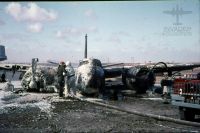
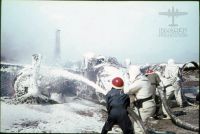
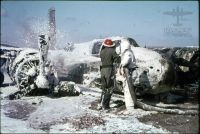
A Makasi T-28D taxis in front of 2 B-26Ks in the Congo.
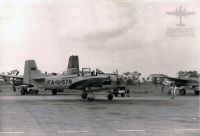
Notes
- ↑ Hagedorn & Hellstrom have a footnote in their book that this unit is either called 22nd Squadron or 22nd Wing and they are very vague about it. Since the T-28 Foundation's claim is much more specific, inluding which group the squadron belonged to, we are going to assume that the T-28 Foundation information is correct at this time.
References
- ↑ http://www.t28trojanfoundation.com/congo.html
- ↑ Jump up to: 2.00 2.01 2.02 2.03 2.04 2.05 2.06 2.07 2.08 2.09 2.10 2.11 2.12 2.13 Hagedorn, Dan and Hellstrom, Leif, (Midland Publishing, 1994), Foreign Invaders- The Douglas Invader in foreign military and US clandestine service. ISBN 1-85780-013-3. Pg. 149-155
- ↑ http://kosubaawate.blogspot.com/2016/01/leopoldville-1957-battle-of-breweries.html
- ↑ http://curtisscommando.e-monsite.com/pages/aircraft/s-n-42-3564-to-42-3577-curtiss-c-46a-30-cu-commando/commando-42-3577.html
- ↑ http://curtisscommando.e-monsite.com/pages/aircraft/s-n-42-3578-to-42-3683-curtiss-c-46a-35-cu-c-46a-36-cu-commando/commando-42-3580.html
- ↑ https://www.planelogger.com/Aircraft/Registration/9Q-CWN/772015
- ↑ https://www.abcdlist.nl/douglas_longbeach_03.html
- ↑ http://www.joebaugher.com/usaf_serials/1943_2.html
- ↑ https://www.orbspatrianostra.com/albums-photos/galerie-photos-congo.html
- ↑ http://aviation-safety.net/wikibase/220911
- ↑ Jump up to: 11.00 11.01 11.02 11.03 11.04 11.05 11.06 11.07 11.08 11.09 11.10 11.11 11.12 11.13 11.14 11.15 11.16 11.17 11.18 11.19 11.20 11.21 11.22 11.23 11.24 11.25 11.26 11.27 11.28 11.29 11.30 11.31 11.32 11.33 11.34 11.35 11.36 11.37 11.38 11.39 11.40 11.41 11.42 11.43 Capote, Vicente Blanco (2011) The Makasis. Scribd. https://www.scribd.com/document/69193132/The-Makasis-2
- ↑ Jump up to: 12.0 12.1 12.2 12.3 12.4 Photo File:Masaki Crew.jpg
- ↑ Jump up to: 13.0 13.1 Photo File:64-17646 and crew.jpg
- ↑ Jump up to: 14.0 14.1 14.2 14.3 14.4 Photo File:Makasi Crew 2.jpg
- ↑ Jump up to: 15.0 15.1 File:Jose Castrsana and TITI Peron at Albertville.jpg
- ↑ Personal Correspondence
